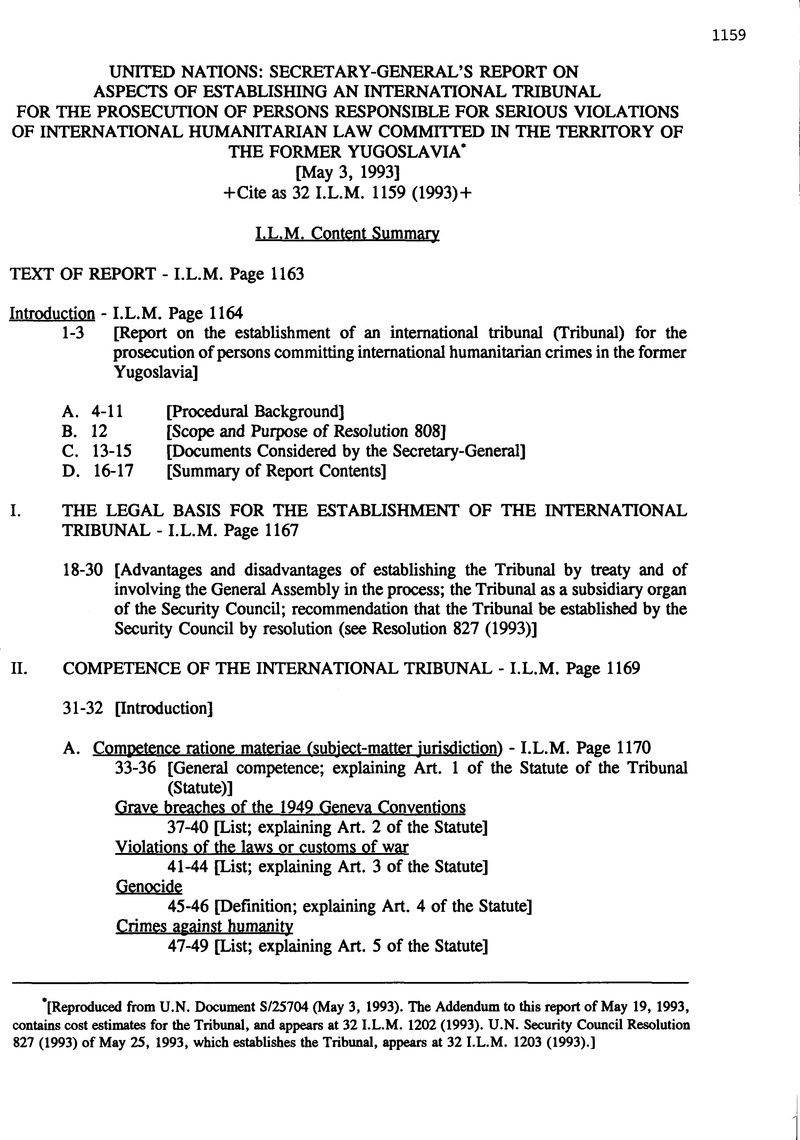Article contents
United Nations: Secretary-General's Report on Aspects of Establishing an International Tribunal for the Prosecution of Persons Responsible for Serious Violations of International Humanitarian Law Committed in the Territory of the Former Yugoslavia
Published online by Cambridge University Press: 27 February 2017
Abstract

- Type
- Reports
- Information
- Copyright
- Copyright © American Society of International Law 1993
References
* [Reproduced from U.N. Document S/25704 (May 3, 1993). The Addendum to this report of May 19, 1993, contains cost estimates for the Tribunal, and appears at 32 I.L.M. 1202 (1993). U.N. Security Council Resolution 827 (1993) of May 25, 1993, which establishes the Tribunal, appears at 32 I.L.M. 1203 (1993).]
* On behalf of the members of the Organization of the Islamic Conference (OIC) and as members of the Contact Group of OIC on Bosnia and Herzegovina.
1/ On 19 April 1993, the Secretary-General addressed a letter to the President of the Security Council informing him that the report would be made available to the Security Council no later than 6 May 1993.
2/ The 1953 Committee on International Criminal Jurisdiction was established by General Assembly resolution 687 (VII) of 5 December 1952.
3/ Convention for the Amelioration of the Condition of the Wounded and Sick in Armed Forces in the Field of 12 August 1949, Convention for the Amelioration of the Condition of the Wounded, Sick and Shipwrecked Members of Armed Forces at Sea of 12 August 1949, Convention relative to the Treatment of Prisoners of War of 12 August 1949, Convention relative to the Protection of Civilian Persons in Time of War of 12 August 1949 (United Nations, Treaty Series, vol. 75, No. 970-973).
4/ Carnegie Endowment for International Peace, The Hague Conventions and Declarations of 1899 and 1907 (New York, Oxford University Press, 1915), p. 100.
5/ United Nations, Treaty Series, vol. 78, No. 1021.
6/ The Agreement for the Prosecution and Punishment of the Major War Criminals of the European Axis, signed at London on 8 August 1945 (United Nations, Treaty Series, vol. 82, No. 251); see also Judgement of the International Military Tribunal for the Prosecution and Punishment of the Major War Criminals of the European Axis (United States Government Printing Office, Nazi Conspiracy and Aggression. Opinion and Judgement) and General Assembly resolution 95 (I) of 11 December 1946 on the Affirmation of the Principles of International Law Recognized by the Charter of the Nürnberg Tribunal.
7/ Reservations to the Convention on the Prevention and Punishment of the Crime of Genocide: Advisory Opinion of 28 May 1951, International Court of Justice Reports. 1951. p. 23.
8/ Official Gazette of the Control Council for Germany. No. 3. p. 22. Military Government Gazette. Germany. British Zone of Control. No. 5. p. 46. Journal Officiel du Commandement en Chef Français en Allemagne. No. 12 of 11 January 1946.
9/ In this context, it is to be noted that the International Court of Justice has recognized that the prohibitions contained in common article 3 of the 1949 Geneva Conventions are based on “elementary considerations of humanity” and cannot be breached in an armed conflict, regardless of whether it is international or internal in character. Case concerning Military and Paramilitary Activities in and against Nicaragua (Nicaragua v. United States of America). Judgement of 27 June 1986: I.C.J. Reports 1986. p. 114.
10/ United Nations, Treaty Series, vol. 999, No. 14668, p. 171 and vol. 1057, p. 407 (proces-verbal of rectification of authentic Spanish text).
- 1
- Cited by




